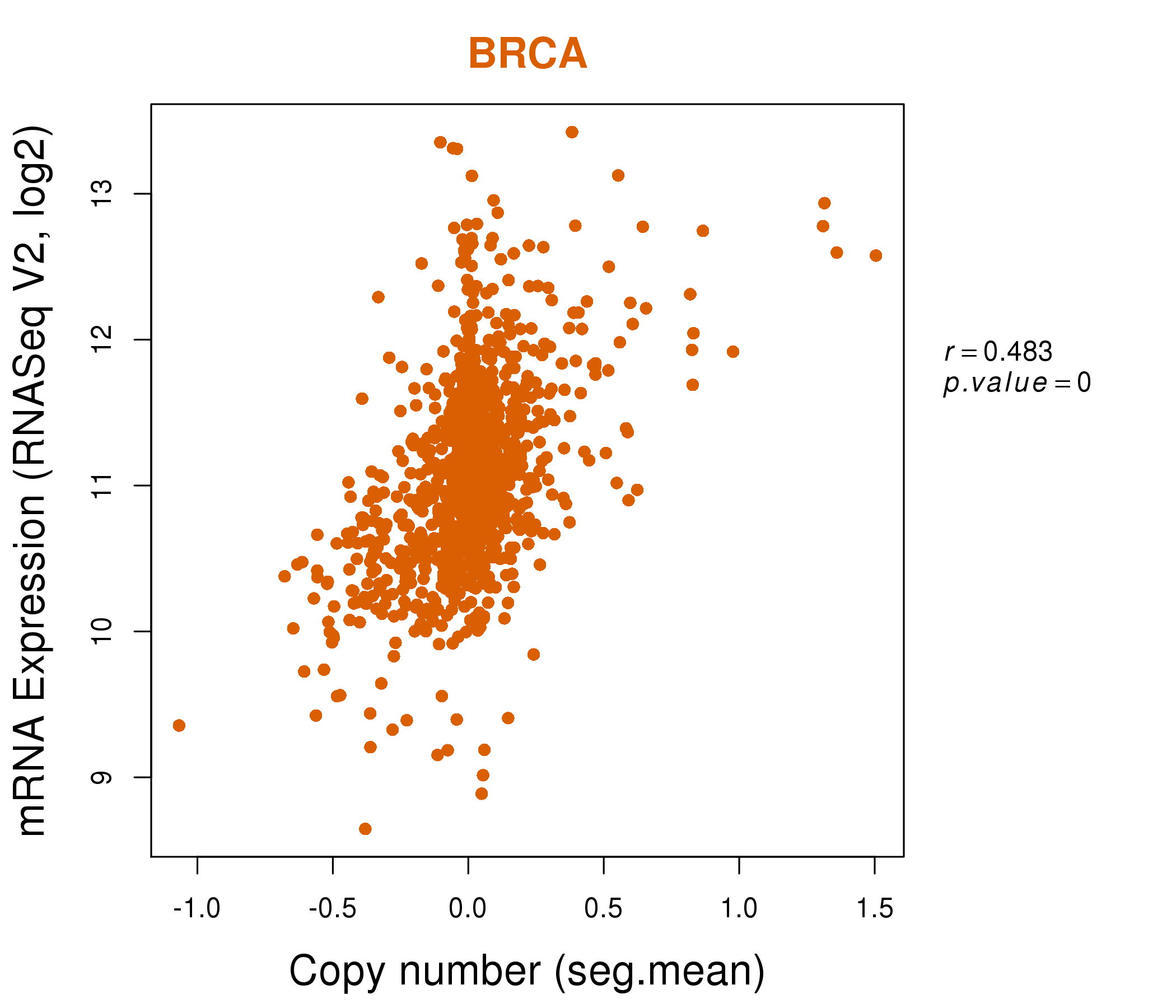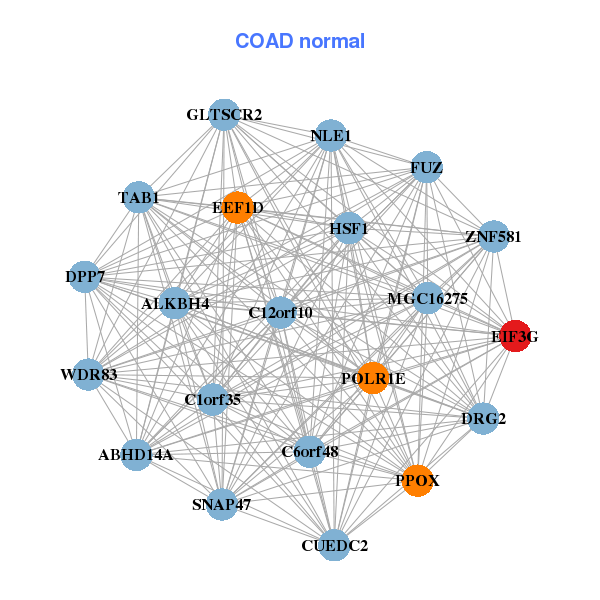|
||||||||||||||||||||||||||||||||||||||||||||||||||||||||||||||||||||||||||||||||||||||||||||||||||||||||||||||||||||||||||||||||||||||||||||||||||||||||||||||||||||||||||||||||||||||||||||||||||||||||||||||||||||||||||||||||||||||||||||||||||||||||||||||||||||||||||||||||||||||||||||||||||||||||||||||||||||||||||
| |
| Phenotypic Information (metabolism pathway, cancer, disease, phenome) |
| |
| |
| Gene-Gene Network Information: Co-Expression Network, Interacting Genes & KEGG |
| |
|
| Gene Summary for EIF3G |
| Basic gene info. | Gene symbol | EIF3G |
| Gene name | eukaryotic translation initiation factor 3, subunit G | |
| Synonyms | EIF3-P42|EIF3S4|eIF3-delta|eIF3-p44 | |
| Cytomap | UCSC genome browser: 19p13.2 | |
| Genomic location | chr19 :10225689-10230599 | |
| Type of gene | protein-coding | |
| RefGenes | NM_003755.3, | |
| Ensembl id | ENSG00000130811 | |
| Description | eIF-3 RNA-binding subuniteIF-3-deltaeIF3 p42eIF3 p44eukaryotic translation initiation factor 3 RNA-binding subuniteukaryotic translation initiation factor 3 subunit 4eukaryotic translation initiation factor 3 subunit Geukaryotic translation initiat | |
| Modification date | 20141207 | |
| dbXrefs | MIM : 603913 | |
| HGNC : HGNC | ||
| Ensembl : ENSG00000130811 | ||
| HPRD : 04886 | ||
| Vega : OTTHUMG00000180396 | ||
| Protein | UniProt: go to UniProt's Cross Reference DB Table | |
| Expression | CleanEX: HS_EIF3G | |
| BioGPS: 8666 | ||
| Gene Expression Atlas: ENSG00000130811 | ||
| The Human Protein Atlas: ENSG00000130811 | ||
| Pathway | NCI Pathway Interaction Database: EIF3G | |
| KEGG: EIF3G | ||
| REACTOME: EIF3G | ||
| ConsensusPathDB | ||
| Pathway Commons: EIF3G | ||
| Metabolism | MetaCyc: EIF3G | |
| HUMANCyc: EIF3G | ||
| Regulation | Ensembl's Regulation: ENSG00000130811 | |
| miRBase: chr19 :10,225,689-10,230,599 | ||
| TargetScan: NM_003755 | ||
| cisRED: ENSG00000130811 | ||
| Context | iHOP: EIF3G | |
| cancer metabolism search in PubMed: EIF3G | ||
| UCL Cancer Institute: EIF3G | ||
| Assigned class in ccmGDB | C | |
| Top |
| Phenotypic Information for EIF3G(metabolism pathway, cancer, disease, phenome) |
| Cancer | CGAP: EIF3G |
| Familial Cancer Database: EIF3G | |
| * This gene is included in those cancer gene databases. |
|
|
|
|
|
| . | ||||||||||||||||||||||||||||||||||||||||||||||||||||||||||||||||||||||||||||||||||||||||||||||||||||||||||||||||||||||||||||||||||||||||||||||||||||||||||||||||||||||||||||||||||||||||||||||||||||||||||||||||||||||||||||||||||||||||||||||||||||||||||||||||||||||||||||||||||||||||||||||||||||||||||||||||||||
Oncogene 1 | Significant driver gene in | |||||||||||||||||||||||||||||||||||||||||||||||||||||||||||||||||||||||||||||||||||||||||||||||||||||||||||||||||||||||||||||||||||||||||||||||||||||||||||||||||||||||||||||||||||||||||||||||||||||||||||||||||||||||||||||||||||||||||||||||||||||||||||||||||||||||||||||||||||||||||||||||||||||||||||||||||||||||||
| cf) number; DB name 1 Oncogene; http://nar.oxfordjournals.org/content/35/suppl_1/D721.long, 2 Tumor Suppressor gene; https://bioinfo.uth.edu/TSGene/, 3 Cancer Gene Census; http://www.nature.com/nrc/journal/v4/n3/abs/nrc1299.html, 4 CancerGenes; http://nar.oxfordjournals.org/content/35/suppl_1/D721.long, 5 Network of Cancer Gene; http://ncg.kcl.ac.uk/index.php, 1Therapeutic Vulnerabilities in Cancer; http://cbio.mskcc.org/cancergenomics/statius/ |
| REACTOME_METABOLISM_OF_PROTEINS | |
| OMIM | |
| Orphanet | |
| Disease | KEGG Disease: EIF3G |
| MedGen: EIF3G (Human Medical Genetics with Condition) | |
| ClinVar: EIF3G | |
| Phenotype | MGI: EIF3G (International Mouse Phenotyping Consortium) |
| PhenomicDB: EIF3G | |
| Mutations for EIF3G |
| * Under tables are showing count per each tissue to give us broad intuition about tissue specific mutation patterns.You can go to the detailed page for each mutation database's web site. |
| - Statistics for Tissue and Mutation type | Top |
 |
| - For Inter-chromosomal Variations |
| There's no inter-chromosomal structural variation. |
| - For Intra-chromosomal Variations |
| * Intra-chromosomal variantions includes 'intrachromosomal amplicon to amplicon', 'intrachromosomal amplicon to non-amplified dna', 'intrachromosomal deletion', 'intrachromosomal fold-back inversion', 'intrachromosomal inversion', 'intrachromosomal tandem duplication', 'Intrachromosomal unknown type', 'intrachromosomal with inverted orientation', 'intrachromosomal with non-inverted orientation'. |
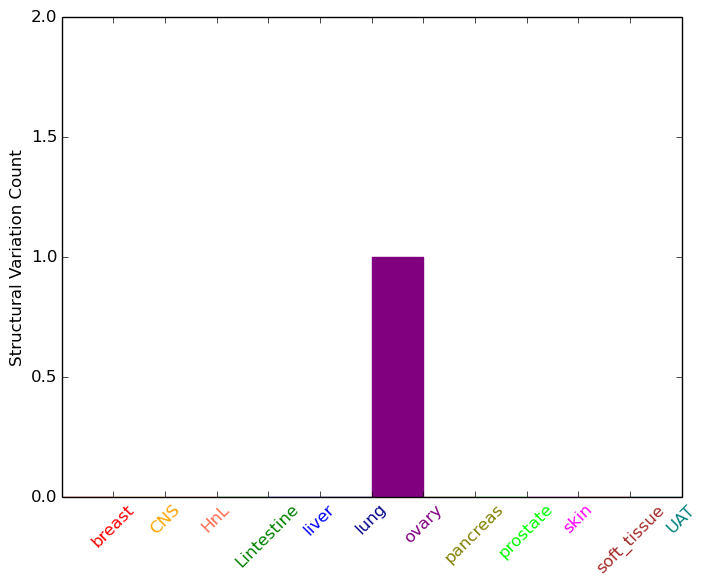 |
| Sample | Symbol_a | Chr_a | Start_a | End_a | Symbol_b | Chr_b | Start_b | End_b |
| ovary | EIF3G | chr19 | 10227867 | 10227887 | EIF3G | chr19 | 10229867 | 10229887 |
| cf) Tissue number; Tissue name (1;Breast, 2;Central_nervous_system, 3;Haematopoietic_and_lymphoid_tissue, 4;Large_intestine, 5;Liver, 6;Lung, 7;Ovary, 8;Pancreas, 9;Prostate, 10;Skin, 11;Soft_tissue, 12;Upper_aerodigestive_tract) |
| * From mRNA Sanger sequences, Chitars2.0 arranged chimeric transcripts. This table shows EIF3G related fusion information. |
| ID | Head Gene | Tail Gene | Accession | Gene_a | qStart_a | qEnd_a | Chromosome_a | tStart_a | tEnd_a | Gene_a | qStart_a | qEnd_a | Chromosome_a | tStart_a | tEnd_a |
| BU844738 | EIF3G | 1 | 325 | 19 | 10229344 | 10230560 | TSEN54 | 324 | 890 | 17 | 73519354 | 73520727 | |
| Top |
| Mutation type/ Tissue ID | brca | cns | cerv | endome | haematopo | kidn | Lintest | liver | lung | ns | ovary | pancre | prost | skin | stoma | thyro | urina | |||
| Total # sample | 2 | |||||||||||||||||||
| GAIN (# sample) | 2 | |||||||||||||||||||
| LOSS (# sample) |
| cf) Tissue ID; Tissue type (1; Breast, 2; Central_nervous_system, 3; Cervix, 4; Endometrium, 5; Haematopoietic_and_lymphoid_tissue, 6; Kidney, 7; Large_intestine, 8; Liver, 9; Lung, 10; NS, 11; Ovary, 12; Pancreas, 13; Prostate, 14; Skin, 15; Stomach, 16; Thyroid, 17; Urinary_tract) |
| Top |
|
 |
| Top |
| Stat. for Non-Synonymous SNVs (# total SNVs=15) | (# total SNVs=9) |
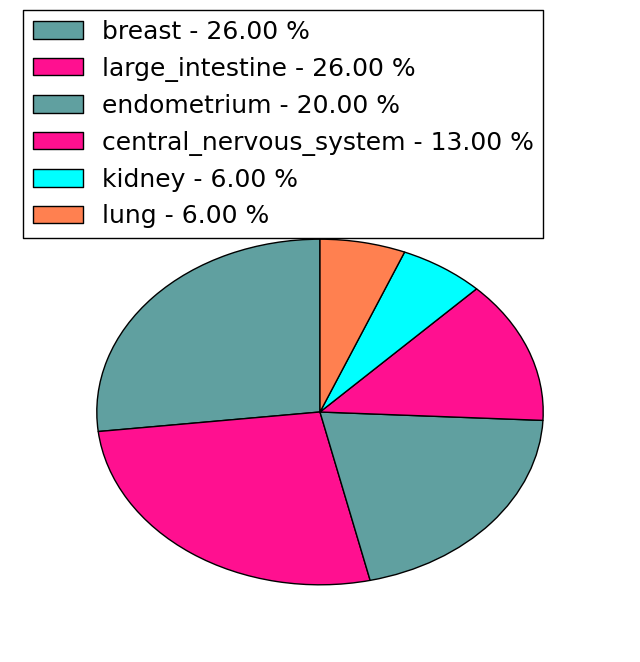 |  |
(# total SNVs=0) | (# total SNVs=0) |
| Top |
| * When you move the cursor on each content, you can see more deailed mutation information on the Tooltip. Those are primary_site,primary_histology,mutation(aa),pubmedID. |
| GRCh37 position | Mutation(aa) | Unique sampleID count |
| chr19:10226256-10226256 | p.F282F | 3 |
| chr19:10229349-10229349 | p.R99W | 2 |
| chr19:10229782-10229782 | p.P45S | 1 |
| chr19:10226423-10226423 | p.F259F | 1 |
| chr19:10227521-10227521 | p.E184K | 1 |
| chr19:10229788-10229788 | p.P43S | 1 |
| chr19:10226424-10226424 | p.F259Y | 1 |
| chr19:10227659-10227659 | p.N138H | 1 |
| chr19:10225802-10225802 | p.P317P | 1 |
| chr19:10229837-10229837 | p.V26V | 1 |
| Top |
|
 |
| Point Mutation/ Tissue ID | 1 | 2 | 3 | 4 | 5 | 6 | 7 | 8 | 9 | 10 | 11 | 12 | 13 | 14 | 15 | 16 | 17 | 18 | 19 | 20 |
| # sample | 3 | 1 | 3 | 1 | 1 | 2 | 1 | 3 | 6 | 2 | ||||||||||
| # mutation | 3 | 1 | 3 | 1 | 1 | 2 | 1 | 3 | 6 | 3 | ||||||||||
| nonsynonymous SNV | 1 | 1 | 2 | 2 | 1 | 2 | 6 | 3 | ||||||||||||
| synonymous SNV | 2 | 1 | 1 | 1 | 1 |
| cf) Tissue ID; Tissue type (1; BLCA[Bladder Urothelial Carcinoma], 2; BRCA[Breast invasive carcinoma], 3; CESC[Cervical squamous cell carcinoma and endocervical adenocarcinoma], 4; COAD[Colon adenocarcinoma], 5; GBM[Glioblastoma multiforme], 6; Glioma Low Grade, 7; HNSC[Head and Neck squamous cell carcinoma], 8; KICH[Kidney Chromophobe], 9; KIRC[Kidney renal clear cell carcinoma], 10; KIRP[Kidney renal papillary cell carcinoma], 11; LAML[Acute Myeloid Leukemia], 12; LUAD[Lung adenocarcinoma], 13; LUSC[Lung squamous cell carcinoma], 14; OV[Ovarian serous cystadenocarcinoma ], 15; PAAD[Pancreatic adenocarcinoma], 16; PRAD[Prostate adenocarcinoma], 17; SKCM[Skin Cutaneous Melanoma], 18:STAD[Stomach adenocarcinoma], 19:THCA[Thyroid carcinoma], 20:UCEC[Uterine Corpus Endometrial Carcinoma]) |
| Top |
| * We represented just top 10 SNVs. When you move the cursor on each content, you can see more deailed mutation information on the Tooltip. Those are primary_site, primary_histology, mutation(aa), pubmedID. |
| Genomic Position | Mutation(aa) | Unique sampleID count |
| chr19:10226446 | p.P215S | 1 |
| chr19:10229788 | p.Q207H | 1 |
| chr19:10226486 | p.E192K | 1 |
| chr19:10229837 | p.N311N | 1 |
| chr19:10226169 | p.Q152Q | 1 |
| chr19:10226670 | p.Y305Y | 1 |
| chr19:10230359 | p.E143K | 1 |
| chr19:10226187 | p.S301P | 1 |
| chr19:10226702 | p.R98K | 1 |
| chr19:10230530 | p.A294V | 1 |
| * Copy number data were extracted from TCGA using R package TCGA-Assembler. The URLs of all public data files on TCGA DCC data server were gathered on Jan-05-2015. Function ProcessCNAData in TCGA-Assembler package was used to obtain gene-level copy number value which is calculated as the average copy number of the genomic region of a gene. |
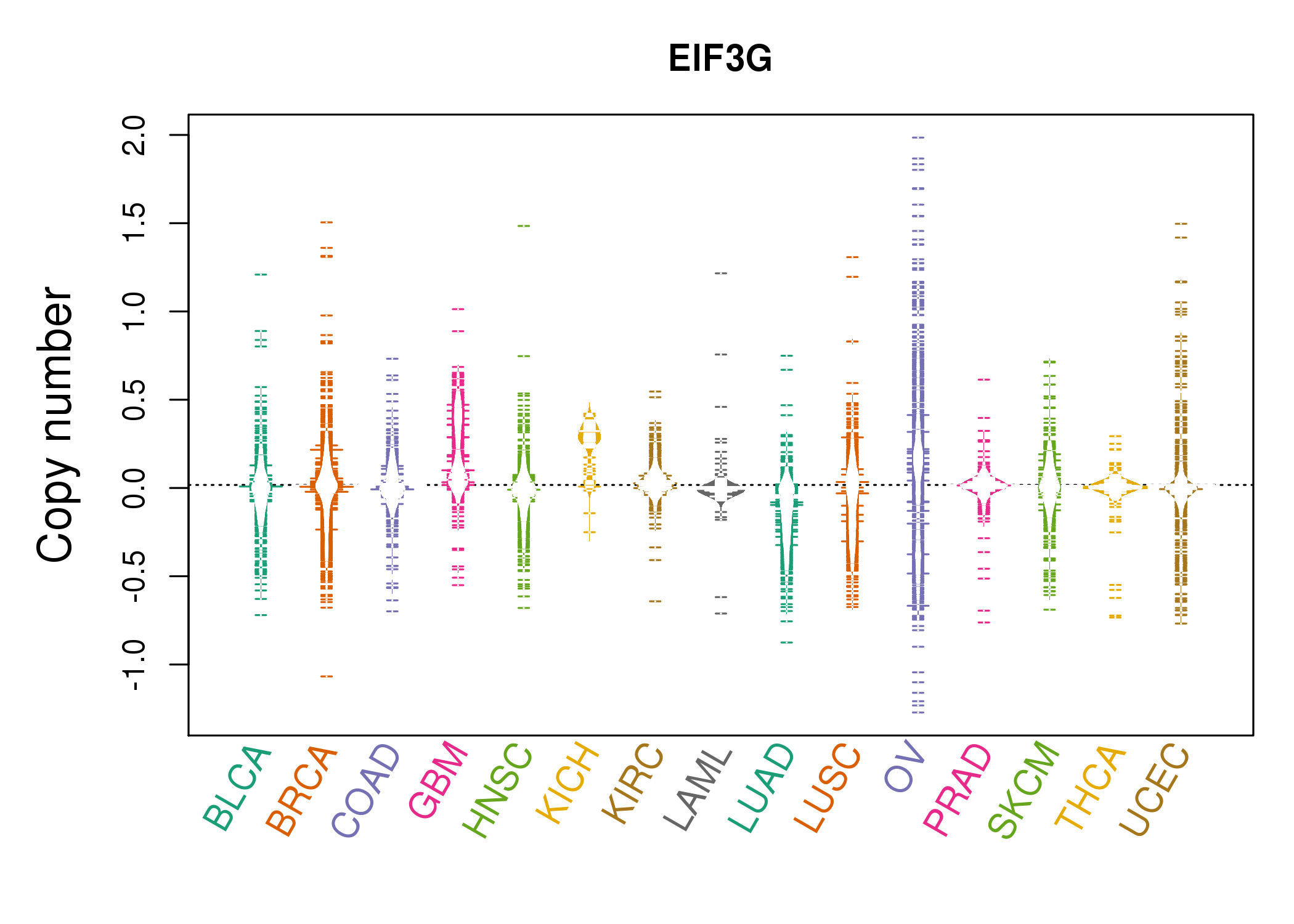 |
| cf) Tissue ID[Tissue type]: BLCA[Bladder Urothelial Carcinoma], BRCA[Breast invasive carcinoma], CESC[Cervical squamous cell carcinoma and endocervical adenocarcinoma], COAD[Colon adenocarcinoma], GBM[Glioblastoma multiforme], Glioma Low Grade, HNSC[Head and Neck squamous cell carcinoma], KICH[Kidney Chromophobe], KIRC[Kidney renal clear cell carcinoma], KIRP[Kidney renal papillary cell carcinoma], LAML[Acute Myeloid Leukemia], LUAD[Lung adenocarcinoma], LUSC[Lung squamous cell carcinoma], OV[Ovarian serous cystadenocarcinoma ], PAAD[Pancreatic adenocarcinoma], PRAD[Prostate adenocarcinoma], SKCM[Skin Cutaneous Melanoma], STAD[Stomach adenocarcinoma], THCA[Thyroid carcinoma], UCEC[Uterine Corpus Endometrial Carcinoma] |
| Top |
| Gene Expression for EIF3G |
| * CCLE gene expression data were extracted from CCLE_Expression_Entrez_2012-10-18.res: Gene-centric RMA-normalized mRNA expression data. |
 |
| * Normalized gene expression data of RNASeqV2 was extracted from TCGA using R package TCGA-Assembler. The URLs of all public data files on TCGA DCC data server were gathered at Jan-05-2015. Only eight cancer types have enough normal control samples for differential expression analysis. (t test, adjusted p<0.05 (using Benjamini-Hochberg FDR)) |
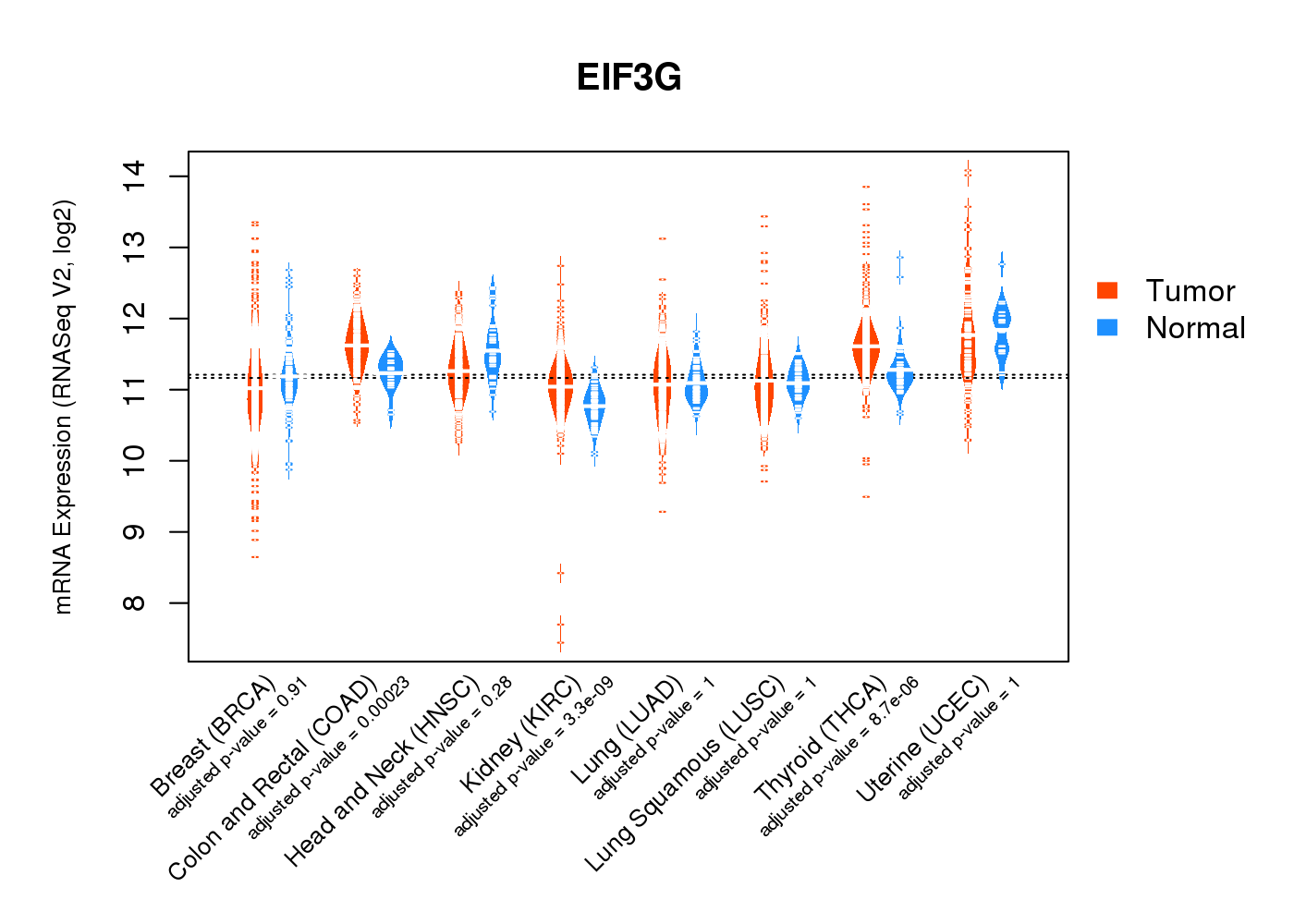 |
| Top |
| * This plots show the correlation between CNV and gene expression. |
: Open all plots for all cancer types
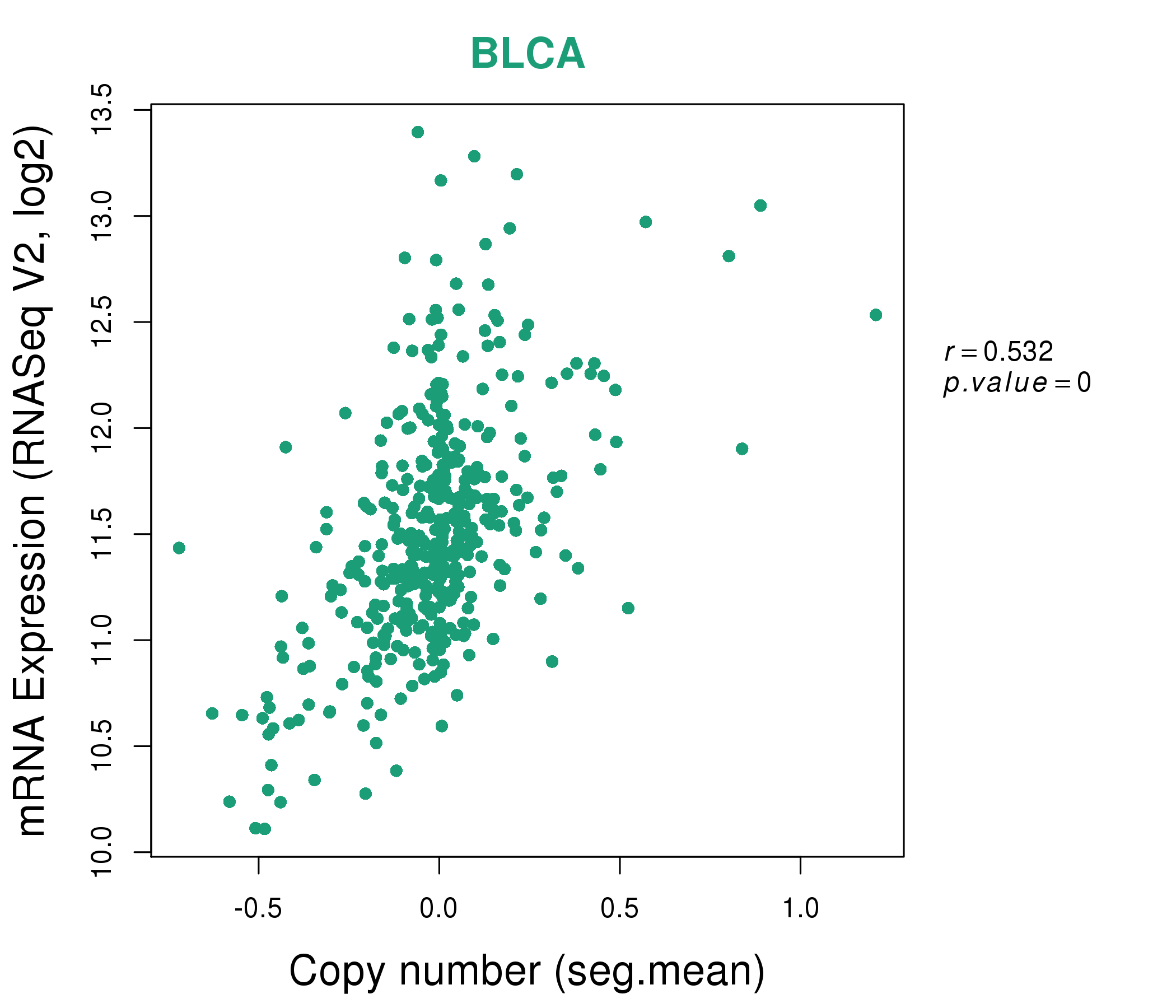 |
|
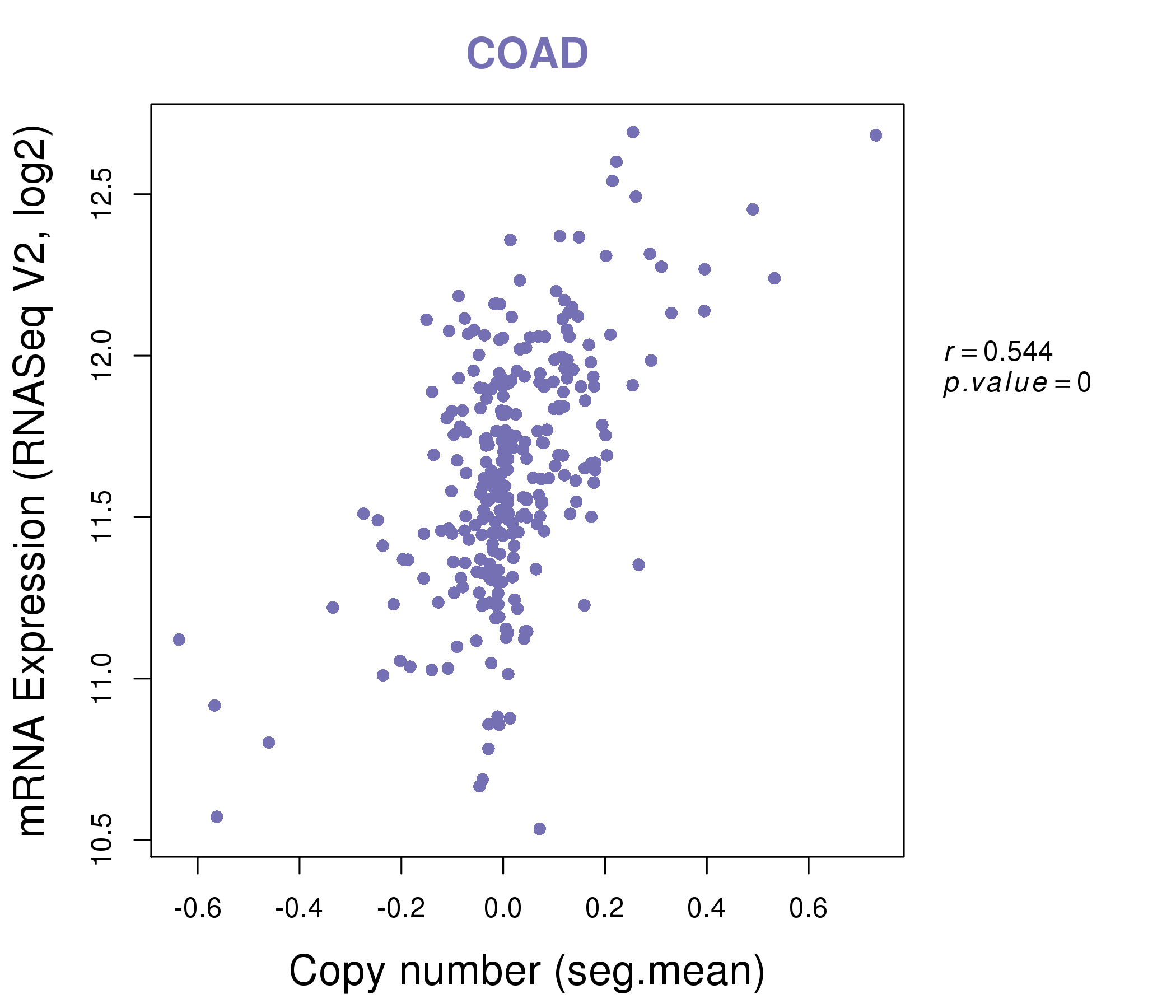 |
|
| Top |
| Gene-Gene Network Information |
| * Co-Expression network figures were drawn using R package igraph. Only the top 20 genes with the highest correlations were shown. Red circle: input gene, orange circle: cell metabolism gene, sky circle: other gene |
: Open all plots for all cancer types
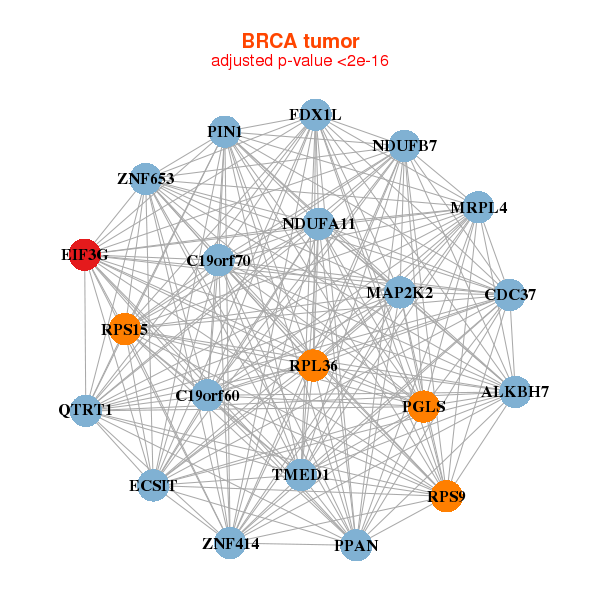 |
|
| ALKBH7,C19orf60,C19orf70,CDC37,ECSIT,EIF3G,FDX1L, MAP2K2,MRPL4,NDUFA11,NDUFB7,PGLS,PIN1,PPAN, QTRT1,RPL36,RPS15,RPS9,TMED1,ZNF414,ZNF653 | VPS51___IFT46,C12orf10,EDF1,EEF1D,EIF3G,FAU,NT5C, POLR2F,PQBP1,PRDX5,RPL13,RPL18,RPL35,RPL36, RPL8,RPLP1,RPS15,RUVBL2,SNRPD2,SURF2,WDR74 |
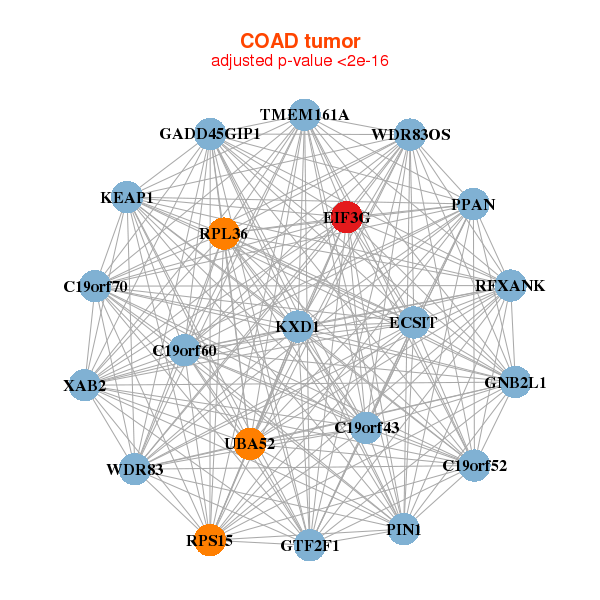 |
|
| C19orf43,KXD1,C19orf52,WDR83OS,C19orf60,C19orf70,ECSIT, EIF3G,GADD45GIP1,GNB2L1,GTF2F1,KEAP1,PIN1,PPAN, RFXANK,RPL36,RPS15,TMEM161A,UBA52,WDR83,XAB2 | ABHD14A,ALKBH4,C12orf10,C1orf35,C6orf48,CUEDC2,DPP7, DRG2,EEF1D,EIF3G,FUZ,GLTSCR2,HSF1,MGC16275, NLE1,POLR1E,PPOX,SNAP47,TAB1,WDR83,ZNF581 |
| * Co-Expression network figures were drawn using R package igraph. Only the top 20 genes with the highest correlations were shown. Red circle: input gene, orange circle: cell metabolism gene, sky circle: other gene |
: Open all plots for all cancer types
| Top |
: Open all interacting genes' information including KEGG pathway for all interacting genes from DAVID
| Top |
| Pharmacological Information for EIF3G |
| There's no related Drug. |
| Top |
| Cross referenced IDs for EIF3G |
| * We obtained these cross-references from Uniprot database. It covers 150 different DBs, 18 categories. http://www.uniprot.org/help/cross_references_section |
: Open all cross reference information
|
Copyright © 2016-Present - The Univsersity of Texas Health Science Center at Houston @ |






